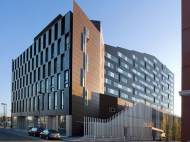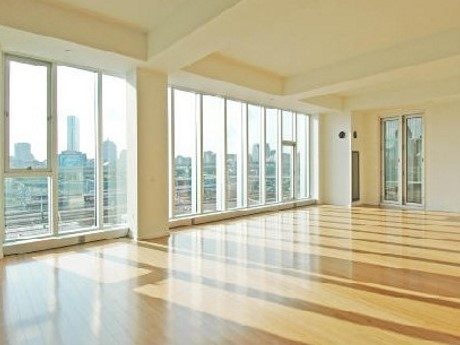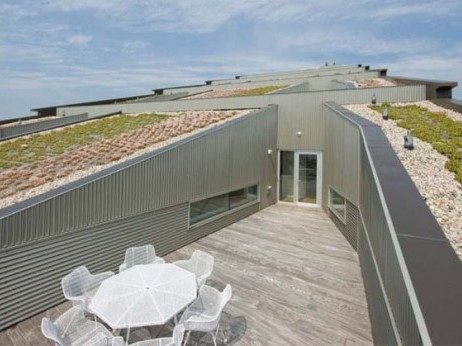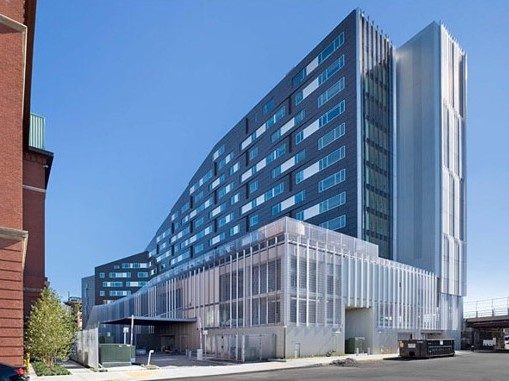Green architecture – Macallen Building
 As a pivotal building in the urban revitalization of South Boston, the Macallen Building design is innovative and sustainable. When it was completed in 2007, the building earned LEED Gold certification. The building consists of 140 luxury condos with high-end finishes and all the amenities you would expect from a luxury condo building. It was designed by Office dA, Inc. and Burt Hill was the Architect of Record.
As a pivotal building in the urban revitalization of South Boston, the Macallen Building design is innovative and sustainable. When it was completed in 2007, the building earned LEED Gold certification. The building consists of 140 luxury condos with high-end finishes and all the amenities you would expect from a luxury condo building. It was designed by Office dA, Inc. and Burt Hill was the Architect of Record.
The Macallen Building structural system is unusual for a residential building and is very efficient in the amount of steel that was required. In addition, the project team chose rapidly renewable resources such as bamboo, cork wallpaper, grasscloth wallpaper, wood-fiber ceiling tile, linoleum flooring, wheatboard, and cotton insulation. Of all the wood used in the project, 75% is certified to Forest stewardship Council standards. Several materials, such as concrete, steel, aluminum siding, rigid insulation, carpet, floor underlayment, and bicycle racks, are recycled content. Most of the materials were locally sourced.
Outdoor air is cleaned with charcoal filters and mechanically introduced into each occupied room. Carbon dioxide levels are measured at the intake and exhaust ducts, and building-operations personnel are notified if the levels exceed an adjustable set-point. Most residential units are wide, open spaces with wall-to-wall ribbon windows or, in some cases, floor-to-ceiling glazed curtain walls. Daylight is abundant, thus reducing the need for additional lightning and heating, and operable windows were cleverly inserted into the design, adding to the rhythm of the exterior facades.
The building is designed to save more than 2 million liters (600,000 gallons) of water annually through the use of dual-flush toilets and an innovative irrigation system. The dual-flush toilets reduce use of potable water for toilet flushing by about 60%, compared with a conventional building. All of the irrigation needs on site are met with collected rainwater and the water collected from air-conditioner condensate, and treated blowdown water from the cooling tower. The project earned a LEED innovation point for this last strategy, which uses a non-chemical treatment system to make the blowdown water safe for irrigation.
This LEED Gold project has a sloped green roof that controls rainwater drainage, filters pollutants and carbon dioxide out of the air, reduces heating and cooling loads, reduces the project’s contribution to the urban heat-island effect, and provides an ecosystem for wildlife. A 20,000 square feet outdoor terrace incorporated into the building provides similar benefits as the green roof. In addition, a covered garage was integrated into the building to reduce overall square footage and contribution to the urban heat-island effect and rainwater runoff.
High efficiency water source heat pumps provide HVAC for the building which add, subtract, and/or transfer heating and cooling energy through a water loop. A cooling tower is provided to reject heat in the summer and a steam heat exchanger (steam is generated of site) is provided to add heat in the winter. Variable frequency drives are utilized at the cooling tower fan, loop water pumps, hot water pumps, and garage exhaust fan to conserve motor energy.
Heating energy is recovered from steam condensate to preheat domestic water. A dedicated ventilation/exhaust air system recovers total energy from exhaust air and transfers it to the ventilation air. Motion sensors are installed to control lighting on garage levels and residential floors corridors to conserve energy. The building consumes 30% less energy compared to a similar conventional building.












Leave your response!